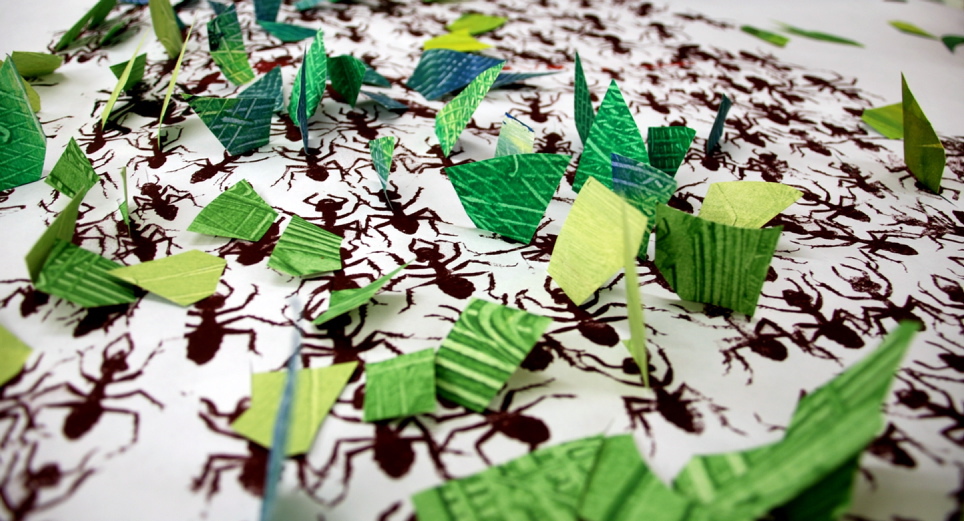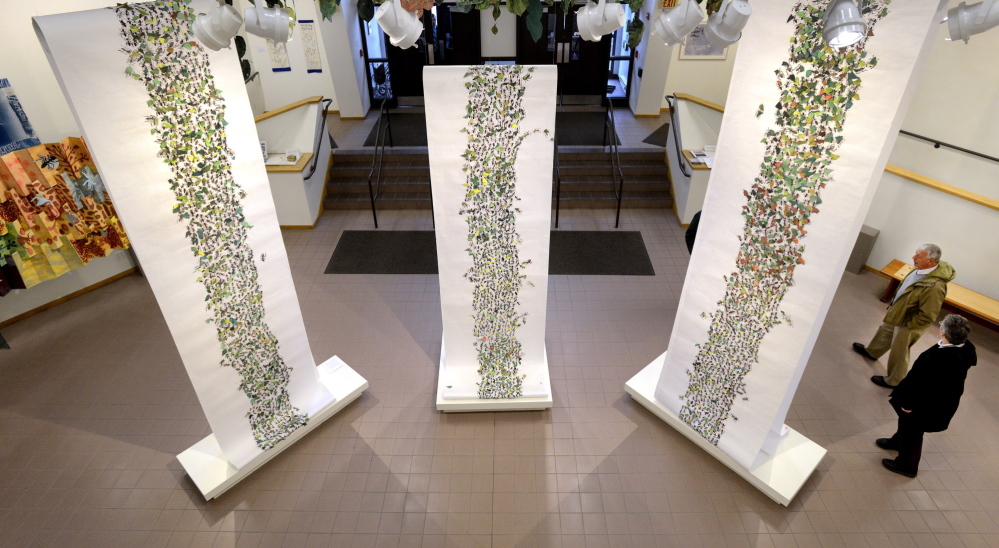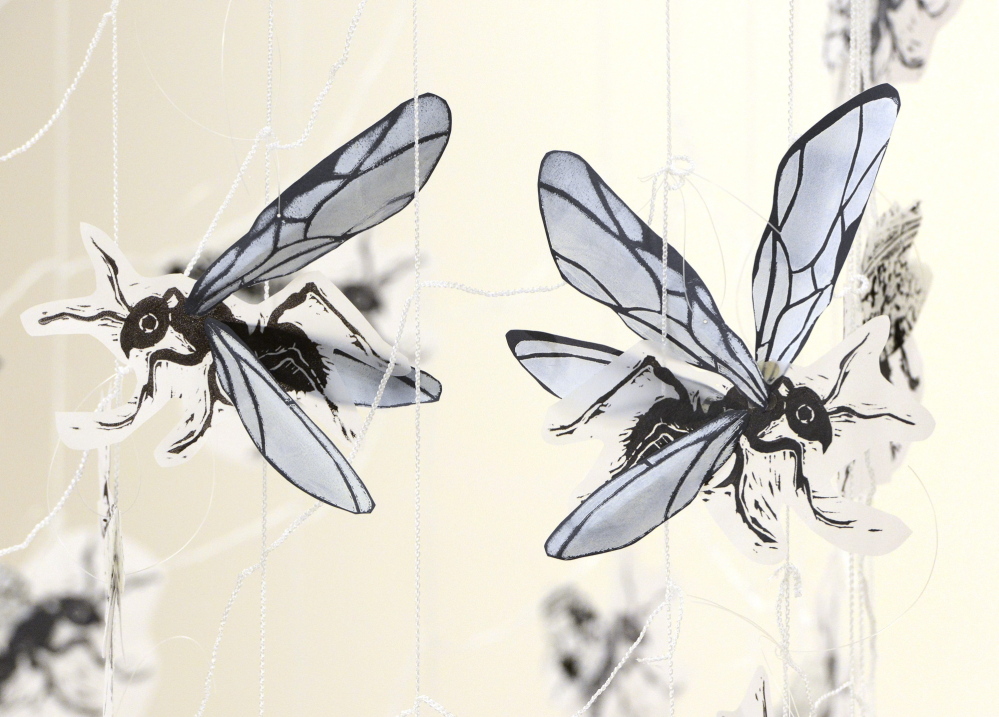LEWISTON — It started with a book.
The artist Vivien Russe read “The Superorganism” by E.O. Wilson and Bert Holldobler, which explains the social structures of insects, such as ants. Enthralled, she called her friend Rebecca Goodale, with whom she has discussed collaborating on an art project. They had yet to settle on a subject, and Russe said to her friend, “Do you think ants would be something to consider?”
Goodale said yes, as did a pair of additional collaborators: Colleen Kinsella and the late Dorothy “Deedee” Schwartz.
And thus was born the quartet now known as the Ant Girls.
Their exhibition, “Ant Farm: At the Nexus of Art and Science,” is on view at the Atrium Art Gallery at the University of Southern Maine’s Lewiston-Auburn College.
“People think of these ants as a nuisance,” Russe lamented. “Bu they’re just so interesting.”
“Ant Farm” is a multimedia collaborative project that merges art and science, inspired by leafcutter ants.
Leafcutters, as the name implies, cut and process leaves and other vegetation for their survival. The ants are among the largest and most complex species on the planet.
Russe was drawn to the social structure of the ants, who move large quantities of leaves and vegetation with a coordinated, factory-like precision. Their underground colonies are large and labyrinth-like.
The Ant Girls, using their skills as printmakers, painters and bookmakers, illustrate the life cycle of leafcutter ants in a large-scale installation that’s nearly as ambitious as the ants themselves.
And nearly as anonymous, as well.
Following the lead of their subjects, the four women worked collaboratively on this project. One suggested an element for the installation and began the art-making process, then passed an unfinished piece on to the next artist, who added something and passed it on.
They signed their work with an embossed chop mark, or stamp. All the work in the main gallery was made as a group.
The first thing visitors see are three paper scrolls that hang from the ceiling and portray thousands of ants. Small bits of paper affixed to the surface suggest the oversized leaves transported by the tiny ants.
The “Fungus Farm” accordion panel brightly demonstrates fungal crops the ants create to cultivate food.
“Wing Pile” shows a mound of discarded wings from the male ants. The interpretation is based in science: Male ants develop wings, mate with their virgin queens and then lose their wings, which are later consumed by the queen to energize her egg-laying endeavors.
The artists began working on this project late in 2011 in Schwartz’s Portland studio. They spent most of 2012 and 2013 making art. Their work became earnest when gallery director Robyn Holman secured a $6,000 grant from the Maine Arts Commission, which led to the exhibition.
“It’s amazing what four women can get done in two years,” Holman said.
Schwartz died in March from lymphoma, just weeks before the exhibition opened.
“To work together was our primary goal,” Kinsella said. “We put our egos aside and worked as a group. It was pure fun. It’s still fun, but it’s a big hole that Deedee has left.”
Schwartz’s husband, Elliott, composed music for the exhibition, along with Caleb Mulkerin. Their recorded soundtrack plays on CDs in the gallery. The musicians layered “ant sounds” and keyboard patterns, creating a bed of ambient music that suggests worker ants scurrying to and fro.
“Ant Farm” is another in a series of exhibitions that Holman has curated with science as a central theme. Last year, she curated a show about pollinators. In 2010, she explored vernal pools. In 2009, she staged an exhibition about invertebrates.
She’s curated at the gallery since 1989, when she began as a volunteer. She was hired three years later.
“I think the intersection of art and science is very interesting,” Holman said. “I like the idea of exploring something that in reality is very small, but making it very large by taking an in-depth look.”
The artists said they appreciate Holman’s authority with both the subject and the gallery. As a beekeeper, she understands the science behind her exhibitions, and takes great care in presenting her shows in a way that elevates the science without taking away from the art.
Among Holman’s admirers is longtime Maine arts writer and critic Carl Little. He called Holman “a consummate curator” and cited her transformation of a foyer in a bland academic building into a vibrant, engaging gallery.
Many artists are inspired by the natural world, Little said, and Holman’s willingness to bring science into her exhibitions is a treat for the viewer.
“More than anyone else in Maine, Robyn has made the connection between art and natural history, and the ants show perfectly exemplifies this,” he said.
Staff Writer Bob Keyes can be contacted at 791-6457 or:
bkeyes@pressherald.com
Twitter: pphbkeyes
Send questions/comments to the editors.






Success. Please wait for the page to reload. If the page does not reload within 5 seconds, please refresh the page.
Enter your email and password to access comments.
Hi, to comment on stories you must . This profile is in addition to your subscription and website login.
Already have a commenting profile? .
Invalid username/password.
Please check your email to confirm and complete your registration.
Only subscribers are eligible to post comments. Please subscribe or login first for digital access. Here’s why.
Use the form below to reset your password. When you've submitted your account email, we will send an email with a reset code.